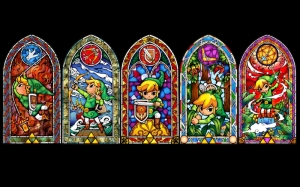
Credit: http://www.wallpaperhi.com/Video_Games/Zelda/link_the_legend_of_zelda_1680x1050_wallpaper_42762
In a recent article on Overthinking It Dot Com, John Perich proposes a narrative similarity between Finnegans Wake and the Legend of Zelda series. It’s a good article, sporting insight about issues of identity implied by Nintendo’s revered series; you should read it.
I’d like to unpack a notion suggested in that article: the Legend of Zelda series does not have a linear continuity but rather an amorphous constellation of narrative elements. For Perich’s purpose, it is enough to unmoor Link and company from contemporary expectations of continuity. Let us go further, though, and determine just what kind of narrative the Legend of Zelda is.
To begin, the name is significant, no? We have here a “legend.” As the settings of each game are roughly medieval European in technology and aesthetic, we can safely say that the series recalls the tradition of medieval storytelling. After the fall of the Roman Empire, much of Europe spent several centuries immersed in intermittent war and constant poverty. Feudal society kept literacy and advanced education confined to the minds of a privileged few. That is to say, the vast majority of the population had practically no access to knowledge of the past outside of the oral tradition, and so, instead of history they had legends.
Middle class citizens of the first world now have history. We can check our Library of Alexandria (Wikipedia) for precise information on who did what, where, and how. Most importantly, we demand to know the when. However, the illiterate poor of medieval society could not check facts beyond the recent history of their village. A grand game of Telephone caused descriptions of events to mutate from telling to telling. Within a few generations, a tale could have changed greatly, its real world origins entirely obscure (if it had any). This storytelling is the practice of legend.
While some video games throw around titles with the word “legend” for marketing effect, the Legend of Zelda actually seems connected to this old form of storytelling. The legend the series tells is that of heroic Link who saves royal Zelda from the grasp of nefarious Ganon to liberate the land of Hyrule. Beyond this summary, the details change with each telling. Just as the village elder’s version of a story differs from the young child’s, so does Ocarina of Time differ from A Link to the Past.
This approach serves video game series well. Many franchises consist of several games with a unified core of gameplay and aesthetic around which developers add novel alterations to sustain players’ attention. To expect a narrative progression that matches our notion of linear history is to flirt with ludonarrative dissonance. Consider the case of Street Fighter. The games tell the story of martial artists competing in an international tournament. Taken as retellings, each entry in the series cleverly reconsiders the questions of who’s in the tournament and how they fight, always keeping the shotokan stylings of Ken and Ryu as constants. Viewed as a historical progression, however, we must suddenly grapple with the discomfort that Street Fighter 4 takes place before Street Fighter 3 and includes characters from Street Fighter 0 that were absent in Street Fighter 2. Ugh.
Video games do not function like other narrative media. We expect components to vary with each playing and the experience of gameplay demands cooperation from the story being told. The Legend of Zelda handles these unique challenges gracefully with its allusion to medieval Europe’s oral tradition.